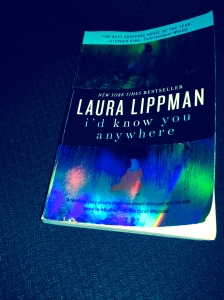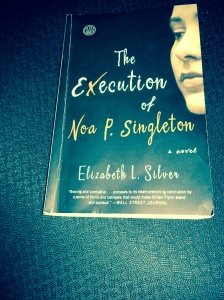Posts Tagged The Execution of Noa P. Singleton
On Death Row–Literary or Women’s Fiction?
Posted by c2london in Reading, Uncategorized, Writing on July 6, 2014
I’ve mentioned my quest to figure out what women’s fiction is, most recently in a blog on book covers. I picked up I’d Know You Anywhere at a recent bookswap, thinking it was women’s fiction. The title sounded like one my WF writing friends had mentioned. Also, the paperback cover features two pictures of the backs of women in what appear to be raincoats. Not the dead giveaway of flowers or children, but hinting it might be for and about women. The book did receive accolades from the likes of Stephen King, as well as decent reviews.

This cover looks even more representational than the real one due to the glossy nature of the material. I had to use a flash.
A month or so prior to reading the above, the Board of the Friends of the Colorado State Library sponsored a talk by Elizabeth L. Silver. She spoke about her 2013 novel, The Execution of Noa P. Singleton. At least two versions of the cover of this novel include a partial face of a woman. What I take to be the hardback edition features only text, with some of the words crossed out. This, too received good reviews, although I am not able to unearth a review on the NYTimes.
What do these novels have in common? Each has a female protagonist. Both have murderers on death row facing dwindling days to their execution. Laura Lippman’s story is told in alternating past and present chapters recounting the story of Eliza’s kidnapping, and what she’s doing now. A few other points of view are included. Occasional sections are about the mother of the young girl for whose murder Walter is to die. Sections of Noa P. include letters the mother of Noa’s victim wrote to her daughter.
How would I categorize these two novels? Are either women’s fiction? In a short article, Rebecca’s Rules: Defining Women’s Fiction (Booklist, March 15, 2013), Rebecca Vnuk suggests that women’s fiction deals with emotions and relationships of a female protagonist, and that “the main thrust of the story is that something happens in the life of that woman.” She then tries to set romance, women’s fiction, and literary fiction apart. One clue, Vnuk says between women’s fiction and literary is if you pay more attention to the beauty of the words than the story. She notes that the two can be confusing to distinguish and also says there is nothing wrong with filing a book under “general fiction.”
Although a large portion of IKYA is from the male antagonist’s point of view, the above definition allows both books to fall into the WF category. Somehow or other, I would never think to call Noa P. a work of women’s fiction. Probably IKYA was published as suspense or crime fiction, but to me, a non-expert on WF, it seemed very much like a novel that could be called women’s suspense fiction. What marked the difference between these two books and their classification?
Both deal with the aftermath of a murder on both the perpetrator, the families of the victim, others involved in the subsequent legal case, and the death penalty itself. Another clue Vnuk gives to distinguish between women’s fiction and literary or general fiction is if the main character can be substituted with a man. Probably this would not work, or would be a completely different story in the case of the Lippman book. In the case of Noa, it might be possible, although it would again make it a much more common story.
The main difference between the two books, and where I would classify them, is in the writing, but not necessarily because I spent more time “admiring the use of language” in Noa than enjoying the story. I didn’t much like the character of Noa. I didn’t like Eliza, either, but for different reasons. Noa was unpleasant but, as someone with at least psychopathic tendencies, interesting. Eliza was plain dull, a wife, a mother, with few interests or thoughts outside of that role. If Lippman’s purpose was to show how being the victim of a crime dulls the senses and impacts the personality, she may have done an excellent job, but it seems to me if that was the intent, there should have been some way to show us that that was what she was doing. Every once in awhile Eliza would know something or show interest in something that seemed to me, as a critical reader, more to advance the story of make a more interesting observation than as something this character would actually say or do or know.
The other characters in the Lippman book–with the exception of Walter whom I felt was well portrayed–were right out of central casting. So many books have a best friend/older sister who feels like every other best friend or sister in every other book in the world. In Eliza’s case, the older sister might be described as “lovingly bullying,” but possessing all the expected traits: the Golden Girl to Eliza’s housewife, the smart one to Eliza’s dropping out of her masters program, the single career woman to Eliza’s long marriage with the “perfect” children. Noa’s only friend, who died in childhood, did not seem like her traits had been purchased in the stock store of characters, although her early demise did not flesh her out.
Eliza’s parents were both oh-so-perfect psychiatrists; again, more a role than real characters. Noa’s mother is quite awful. Her father is a reformed convict and not much like fathers in other books. Both are believable, but not particularly likeable. Eliza’s husband is too good/smart/understanding to be true. I kept expecting him to fail her, to in some way make her perfect life a lie. That would have made the story more complex and interesting, but in the end, he’s left home so that the sister can finish out the novel with Eliza.
Noa P. was told in the first person while Eliza’s story was all third. Eliza’s thoughts and feelings were explained and then explained again, while Noa held back information and lied, making you have to work to figure out what was going on in the dialogue as well as the rest of the story. This telling of emotions very well might be what I most objected to in the Lippman book. This over-explaining with dialogue that seldom rang true was for me what made this a less interesting read. I wonder if this problem might have been fixed if Eliza had told her part of the story in the first person.
I have to continue my search for “real” women’s fiction. I hope that some of what, for me, are deficits in the style of writing do not define the “genre.”